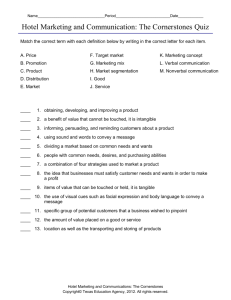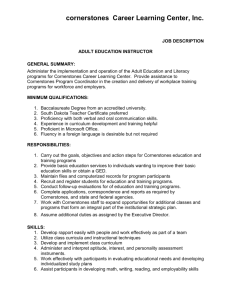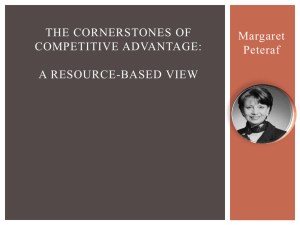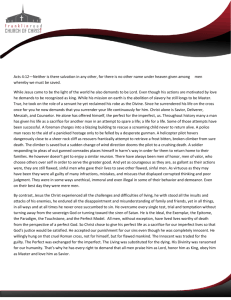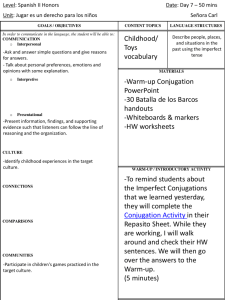Slides
advertisement
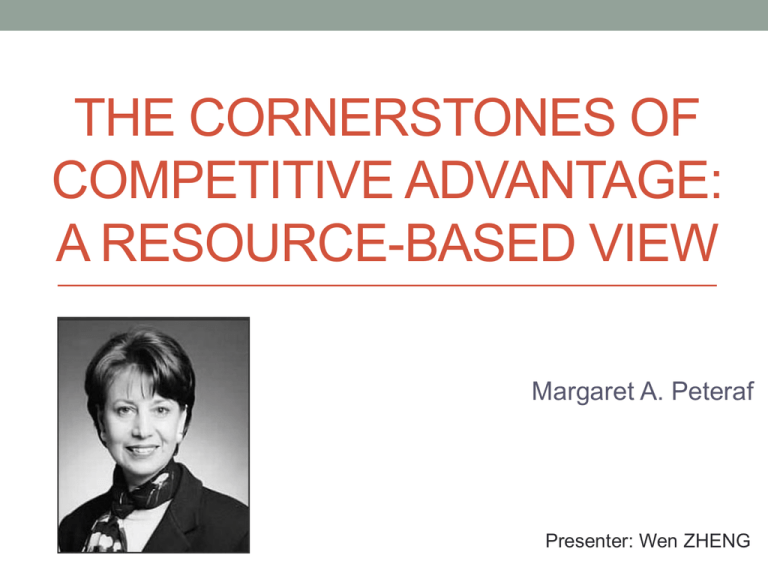
THE CORNERSTONES OF COMPETITIVE ADVANTAGE: A RESOURCE-BASED VIEW Margaret A. Peteraf Presenter: Wen ZHENG Research Question • Develop a general model of resources and firm performance, which at once integrates the various strands of research and provides a common ground from which further work can proceed. • Four cornerstones of competitive advantage • Applications of the resource-based model Cornerstones • Heterogeneity • Ex Post Limits to Competition • Imperfect Mobility • Ex Ante Limits to Competition Cornerstones • Heterogeneity • Ex Post Limits to Competition • Imperfect Mobility • Ex Ante Limits to Competition Heterogeneity • Resource and capabilities are heterogeneous across firms. (Barney, 1991) • Superior Resources (Limited supply) • Ricardian rents Scarcity of resource supply • Monopoly rents Restriction of output Cornerstones • Heterogeneity • Ex Post Limits to Competition • Imperfect Mobility • Ex Ante Limits to Competition Ex post limits to competition • Condition of heterogeneity can be preserved • Competition • Ricardian Rents: supply of scarce resource (supply curve elasticity) • Monopoly Rents: output (individual demand curve elasticity) Ex post limits to competition • Imperfect substitutability: • Demand elasticity (Porter, 1980) • Imperfect imitability • Entry barrier (Bain, 1956) • Isolate industry participants from potential entrants • Mobility barrier (Caves and Porter, 1977) • Isolate groups of similar firms in a heterogeneous industry • Isolating mechanisms (Rumelt, 1984, 1987) • Property rights, information asymmetries, frictions, causal ambiguity, producer learning, buyer switching cost, reputation, buyer search costs, channel crowding, economies of scale • Failure of competitive market (Yao, 1988) • Production economies; sunk cost; transaction cost; imperfect information • Firm orientation (Ghemawat, 1986) • Size advantage, preferred access to either resources or customers, restrictions on competitors’ options • Valuable but non-tradeable assets (Dierickx and Cool, 1989) • Time compression diseconomies, asset mass efficiencies, interconnectedness of asset stocks, asset erosion, and causal ambiguity Cornerstones • Heterogeneity • Ex Post Limits to Competition • Imperfect Mobility • Ex Ante Limits to Competition Imperfect Mobility • Perfectly immobile • Property rights are not well defined (Dierickx and Cool, 1989; Meade, 1952; Bator, 1958) • Idiosyncratic and no other use out side the firm (Williamson, 1979) • Imperfectly mobile • Resources are specialized to firm-specific needs (Montgomery and Wernerfelt, 1988) • Co-specialized assets (Teece, 1986) • Transaction cost is high (Williamson, 1975; Rumelt, 1987) • Necessary conditions for Sustainable competitive advantage • Resource will remain available to the firm • Rents will be shared by the firm • The opportunity cost does not offset the rent (next best potential users) Cornerstones • Heterogeneity • Ex Post Limits to Competition • Imperfect Mobility • Ex Ante Limits to Competition Ex ante limits to competition • Prior to any firm’s establishing a superior resource position, there must be limited competition for that position. • Economic performance depends on both the returns of the strategies and cost of implementing the strategy (Barney, 1986) Cornerstones Applications • Why do some firms outperform others? • Help managers understand, preserve, or extend their competitive advantage – Single Business Strategy – Corporate Strategy Single Business Strategy • Help managers have a clear understanding of whether their situation meets necessary conditions for a sustainable advantage • Differentiate valuable from less valuable resource • Mobility • Imitable • License vs. Internally develop • Imperfect mobile internally develop • Co-specialized assets internally develop Corporate Strategy • Scope of the firm • Barney (1988): strategically related acquisition • How rare and inimitable is the resulting combination of resources • Montgomery and Hariharan (1991): diversification • Broad resource bases • Theory of diversification • Quasi-fixed fungible • Excess capacity in resources+ high transaction cost • Paradox “excess capacity” “scarcity rents” • Montgomery and Wernerfelt (1989): extent of diversification • Specificity + market opportunities extent of diversification • Dosi, Teece and Winter (1990): “coherence” of business activity • Core competence degree of “coherence” • Speed of learning, breadth of the path dependencies, degree of asset specialization and nature of selection environment scope of firm
